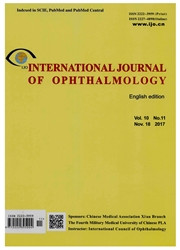

 中文摘要:
中文摘要:
AIM: To evaluate the outcomes and safety of lamellar keratoplasty(LK) assisted by fibrin glue in corneal perforations. ·METHODS: Six eyes of 6 patients affected by different corneal pathologies(2 posttraumatic corneal scar and 3 bacterial keratitis) underwent LK procedures by using fibrin glue. The mean corneal perforation diameter was 1.35 ±0.64mm(range,0.7-2.5mm),and the greatest diameter of the ulcerative stromal defect was 2.47 ± 0.77mm in average(range,1.5-3.5mm). The donor corneal lamella diameters were 0.20-mm larger and thicker than the recipient to restore a physiologic corneal thickness and shape: mean donor diameter was 8.34 ± 0.28mm(range,8.2-8.7mm) and mean thickness was 352±40.27mm(range,220-400mm). Mean follow-up was 7.33±1.97 months(range,6-11 months). Postoperatively,the graft status,graft clarity,anterior chamber response,the visual prognosis,intraocular pressures,and postoperative complications were recorded. ·RESULTS:Allthecornealperforationsweresuccessfully healed after the procedure. The best-corrected visual acuity(BCVA) ranged from 20/1 000 to 20/50 in their initial presentation,and from 20/100 to 20/20 in their last visit,showed increase in all the patients. No major complications such as graft dislocation and graft failure were noted. Neovascularization developed in the superficial stroma of donor graft in 1 case. High intraocular pressure developed on day 2 after surgery,while was remained in normal range after application of anti-glaucomatous eyedrops for 1 week in 1 case. ·CONCLUSION: Fibrin glue-assisted sutureless LK is valuable for maintaining the ocular integrity in the treatment of corneal perforations.
 英文摘要:
英文摘要:
AIM: To evaluate the outcomes and safety of lamellar keratoplasty(LK) assisted by fibrin glue in corneal perforations. ·METHODS: Six eyes of 6 patients affected by different corneal pathologies(2 posttraumatic corneal scar and 3 bacterial keratitis) underwent LK procedures by using fibrin glue. The mean corneal perforation diameter was 1.35 ±0.64mm(range,0.7-2.5mm),and the greatest diameter of the ulcerative stromal defect was 2.47 ± 0.77mm in average(range,1.5-3.5mm). The donor corneal lamella diameters were 0.20-mm larger and thicker than the recipient to restore a physiologic corneal thickness and shape: mean donor diameter was 8.34 ± 0.28mm(range,8.2-8.7mm) and mean thickness was 352±40.27mm(range,220-400mm). Mean follow-up was 7.33±1.97 months(range,6-11 months). Postoperatively,the graft status,graft clarity,anterior chamber response,the visual prognosis,intraocular pressures,and postoperative complications were recorded. ·RESULTS:Allthecornealperforationsweresuccessfully healed after the procedure. The best-corrected visual acuity(BCVA) ranged from 20/1 000 to 20/50 in their initial presentation,and from 20/100 to 20/20 in their last visit,showed increase in all the patients. No major complications such as graft dislocation and graft failure were noted. Neovascularization developed in the superficial stroma of donor graft in 1 case. High intraocular pressure developed on day 2 after surgery,while was remained in normal range after application of anti-glaucomatous eyedrops for 1 week in 1 case. ·CONCLUSION: Fibrin glue-assisted sutureless LK is valuable for maintaining the ocular integrity in the treatment of corneal perforations.
 同期刊论文项目
同期刊论文项目
 同项目期刊论文
同项目期刊论文
 期刊信息
期刊信息
